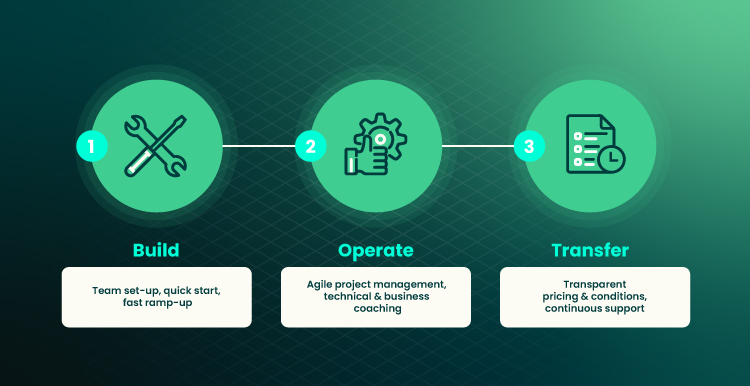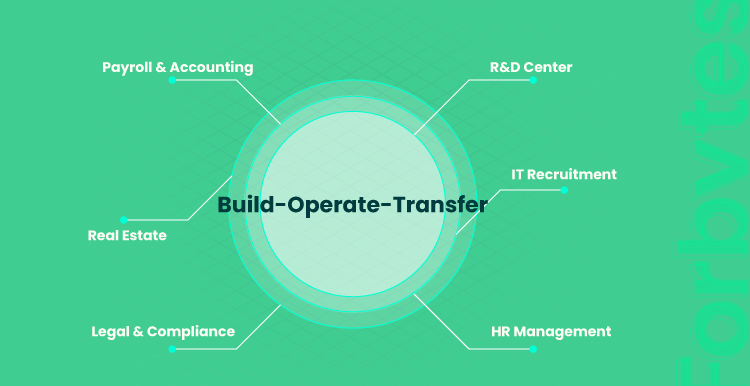When people choose to outsource, they go for the optimal cost and high quality of services. These are the main benefits that encourage businesses to look for nearshore or offshore software engineering partners and entrust the projects to third parties. But in outsourcing, there are risks that can damage any project. To reduce the uncertainties to a minimum, companies choose build operate transfer model.
Build-operate-transfer (BOT) model is a revolutionary approach gaining popularity on the IT market. Today, we’ll discuss the essentials of BOT in IT outsourcing and explain when it’s the best choice to implement this model on a project.
Build Operate Transfer – What Does It Mean?
BOT (build-operate-transfer) is defined as a contractual delivery model implemented by a client and a BOT services company. To put it simply, there is a BOT company that signs a contract with a client. The BOT service provider builds, sets up, and operates a new core business, operation unit, or service delivery process. For some time, the ownership of the project belongs to the private company. After the right time comes, the private sector party transfers the ownership rights to the client.
You may ask, how does a client benefit from this model? Why do they complicate things instead of choosing the traditional outsourcing model? The answer is simple. A client wins from implementing this hybrid model because they transfer the responsibility for the project to another vendor. For some time, all project risks and challenges are managed by the vendor. The private entity takes responsibility for all processes and procedures that take place on the project. Yes, the client waits for a longer time compared to traditional contracts. But in the end, they get an effective business, project, or solution with optimized and stable processes. Usually, BOT is one of the project delivery mechanisms that is implemented in big and multi-layered projects.
3 Stages of BOT
The BOT model consists of the 3 phases: build, operate, and transfer. Let’s discuss them in more detail.

Stage 1: Build
The build phase starts with market research and the analysis of the client’s capacities, goals, and needs. This phase involves many processes and requires deep planning from you and your partnering company. The main processes include choosing a building where the work will take place, composing a team, developing and establishing the IT infrastructure, and much more. The build stage also includes the process of team employment. Under the build operate transfer model, your outsourcing partner will have to provide the legal framework for the project’s functioning. The partnering company will also have to provide the staff with hardware and comfortable work conditions.
Stage 2: Operate
This stage covers the creation of something new or building processes and optimizing them. Everything from creating a product to maintaining it and offering technical support is done by a BOT service provider. They also implement the growth strategy once everything works well and scale the project according to the plan. The team coaching sessions may also be part of the operate phase. They are conducted to increase the maturity and effectiveness of a project and bring it closer to the transfer phase.
Stage 3: Transfer
This is the final phase of BOT. At this stage, the ownership rights are transferred from a third-party vendor to a client. It occurs after the client company declares that they are ready to handle the project on their own. In other words, the transfer phase starts when the client company is mature enough to take the responsibility for the project.
BOT Model in IT Outsourcing
In software outsourcing, a BOT vendor is a software engineering company. Under the BOT agreement, a software engineering vendor sets up, owns, and optimizes a software development center for a certain period of time. After the contract period comes to an end and the center reaches operational excellence, the ownership is taken by a client.
Let’s move to build-operate-transfer examples. A good instance of this model at work is setting up the R&D department in the offshoring locations. You sign a BOT agreement with the service provider. The executor is obliged to set up and maintain an R&D department until it’s mature enough and until you decide to take over the ownership. The partnering company will have to find the building for your offshore office, hire staff, set up operational processes within the captive center, etc.
In software outsourcing, this model is used to minimize the risks and get rid of the extra responsibility. If a client chooses the traditional cooperation model, they get a solution that is ready to go live and grow. But the growth depends on the client’s decisions and the strategy they choose. Once the client makes the wrong decision, it will impact the effectiveness of the solution. In contrast to this, the BOT model enables the client to minimize risks and prevents them from experiencing technical difficulties. The responsibility for the functioning and operation of the solution relies on a private company. Once something goes wrong, the vendor will have to fix it. In the end, the client gets a solution that is ready to function stably.
3 Reasons to Consider Build Operate Transfer
Earlier, the build operate transfer model was implemented in financial projects. It was also applied in public-private partnerships.

But the flexibility and security of BOT projects have made this model popular among different industries and organizations. Companies refer to BOT because of the following reasons:
You keep your money safe
As a business owner, you know how important it is to invest in the right decisions. Investing in the right decisions will cost you less than investing in the wrong. Businesses prefer to invest more at the start but get higher chances for success instead of putting their future at stake but saving money at the beginning. This explains why BOT becomes so popular nowadays.
You reach time efficiency
Time is everything. If your digital capabilities allow you to do so, it’s better to pay with your money than with your time. If a business loses time, it loses opportunities. BOT model prevents you from losing time. You delegate the operation workload to the experts in the focus industry. Meantime, you can devote yourself to strategic decisions and processes that generate greater value.
Here, we’ll mention one of the build operate transfer examples. Suppose that you built a project and it’s now at the stage of tech enhancement. It may take a few days for you to figure out how some tech processes work. Instead of spending 2 days on this, you can choose BOT strategy and pay for 1 hour of work by someone who’s deeply experienced in these processes. That is, it will take them 1 hour to complete the task and move on. Meantime, you can use these 2 days for doing something value-added. Just think of the volume of time you can save if opting for the BOT approach. Compared with traditional models, it’s a smarter strategy that leads to efficiency and more effective time management.
You get no stress
Your dedicated in-house team is not alone in their goal of establishing a new business or operation. They partner up with an experienced outsourcing company that provides quality BOT services. These circumstances reduce the stress level experienced by your team. They leave their capacity for the creative, income-generating, and insightful part of their job.
4 Main Benefits of BOT Model
As a rule, the BOT approach is chosen by big enterprises that delegate their software engineering project to a business partner. But when the benefits BOT offers prevail over risks, small projects also opt for this model. For example, you plan to launch a business project abroad. Starting a new business in the foreign environment means a lot of risks and challenges. To minimize them and increase your chances for success, you can choose BOT (build-operate-transfer). In this case, all the risks associated with the start-up stage of your business will lie on a partnering company. It will take some time for your partner to grow the project and ensure stable functioning. You can use this time for strengthening your business entity as a whole and implement your strengths in the new project.
Here is what the implementation of BOT can bring to your business.
Minimum risks
If you choose BOT, your project will be handled by an experienced team. Instead of hiring staff for the long term and investing in team extension, you will delegate the operation to a third-party vendor. Their experience and cross-industry competencies will give you confidence in the strategy chosen for your project. What’s more, a quality BOT partner won’t join the project that is not viable. Before you sign a contract, your project idea will go through multiple checks and evaluations to make sure that it is interesting for the target audience.
Moreover, the partnering company is well acquainted with the local requirements and local laws under which the project will grow. They are aware of all the pitfalls that wait for you along the way. Delegating your project to a BOT company will help you secure your investment and choose the right path with regard to local law.
Resources at hand
One of the strongest benefits of the BOT project delivery mechanism is that you do not need to accumulate resources, hire software product engineers, or provide them with the software and hardware essential for project execution. The BOT approach ensures that the project team has the necessary resources at hand. The staff is already competent in the focus industry and well-trained to solve challenges that may arise on the project. What’s more, BOT teams usually strive for innovation. They implement the newest technologies on the projects. You’ll have no need to pay for staff training, technology use, and other related processes. Instead, you can refer to the BOT services and get the solution you expect without extra effort.
Effectiveness
Your BOT team can cooperate with your in-house team to bring more value to the project. The in-house team will share their experience and vision, which can be implemented in a project by the build-operate-transfer team. The build operate transfer team will work as an independent entity but they will be immersed into your corporate culture. Your in-house and BOT teams can have regular communication sessions where they will share the progress, brainstorm ideas, and generate insights.
The cooperation between the in-house team and build operate transfer team is very important before the transfer stage. At this stage, the project’s methodologies and operations are adjusted to the needs and peculiarities of the client’s company. Before the client takes full control over the project, the project will be adjusted to the requirements.
Growth speed
If you lack resources for fast growth and scaling your project up, you can delegate this task to a software product engineering partner. By doing so, you increase your chances for successful project completion. Estimate the cost of the possible challenges and risks that you can face after the project release. If you can handle them, you can choose the traditional outsourcing model. If it can damage your company, opt for BOT. Yes, this model will make you invest more in the project at the start. However, you will be safe tomorrow and get assurance that your investments will bring positive results.
What’s more, BOT speeds up the time to market. If you target the foreign market, you should ensure an uninterrupted project lifecycle and growth. When you are located in a different time zone, you cannot physically be present at each stage of the project. It will take a lot of time for you to notice the issue distantly, respond to it, and find a solution. In this case, choose the BOT. This model enables your partner to keep track of the progress and intervene in the project anytime needed.
Conclusion on Build-Operate-Transfer
In this article, we’ve discussed everything you should know about the BOT model. When to choose it? BOT is the best choice in cases when you have extra resources that you want to invest in the IT project but don’t want to take all risks and responsibilities on yourself. Instead, you prefer to pay money to a trusted vendor doing it for you.
By choosing build-operate-transfer, you minimize the risks associated with launching an IT project. That’s why more and more businesses use this model for opening new R&D departments oversea. If you look for a quality BOT service provider that specializes in software product engineering and has vast experience, you are at the right place. Forbytes has more than 10 years of experience on the market and offers a wide range of services that can satisfy the needs of custom projects. Contact us to discuss the conditions and perks that our team will offer under the BOT agreement.

Our Engineers
Can Help
Are you ready to discover all benefits of running a business in the digital era?

Our Engineers
Can Help
Are you ready to discover all benefits of running a business in the digital era?







